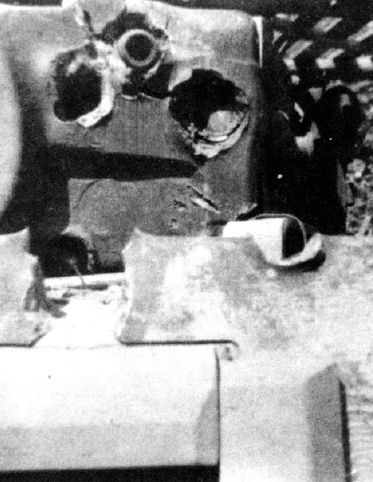Tank Lovers Group
Hobbies & Interests
This group is for everyone who like tanks, sci-fi tanks, real tanks, funny tanks, you can put here tank mods, tank maps, simply everything with straps, armor and gun :D
122mm & 85mm guns failed to penetrate Tigers armor
(view original)
Post a comment
Description
Heavy damage conflicted by large calibred 122mm and medium caliber 85mm guns on this Tiger I front armor (gun mantlet 110mm thick) but no penetration. Thou the 122mm hit was apperently received by a HE shell as AP would go fully through.
Afterall most IS-2 tanks were given only HE shells as they were designed to break through defence lines and destroy bunkers, they were not always intended for anti tank. But there was the SU-85 and SU-100 also...






Not so :) They intentionally tested effect of 122 mm shells on german tanks. On Tiger II. During the tests, HE grenade OF-471, shooted from IS-2, hit Tigers II frontal armor, wrecked it's transmissions and torn welded seams. That's why, my verdict is: it is not HE shell. The fact that the shell got stuck in armor says that, most likely, it is acutelyheaded caliber armor projectile BR-471. Reasons why it didn't penetrate armor could be:
1) shell hit armor at too high angle. (probable);
2) shell hit armor at the distance more than 1500 metres BEFORE the autumn of 1944 (most probable);
3) shell hit armor at the distance more than 3000 metres AFTER the autumn of 1944 (least probable).
Besides, for destruction of bunkers and fortifications Red Army used not only SU-85/85M/100, but also SU-122(which they prefered even more). Production of SU-122 was very limited, but nevertheless, few of them even attacked Berlin.
Could easily be none of those. Quality control wasn't so great in WWII, least of all in Germany, so the steel on this Tiger could just be significantly stronger than what it was assumed to have during whatever testing or analysis used to determine if a 122mm gun could penetrate it.
Plus, it could have just been lucky. Those armor penetration tables are good for averages at best, one can't look at one and conclude a shell would penetrate so much armor every time.
Seconding that it was only hit with AP though. HE makes a kind of flower shaped spattering where it hits, and certainly wouldn't bore into the armor like that.
In 2) and 3) I was talking exactly about the quality. Since the summer-autumn of 1944, due to the high lack of manganese, germans commenced using high-carbon armor, doped with nickel, which was more fragile, especially in the places of welded seams. And here is a result of higher vulnerability of german tanks. Actually the could be other problems in quality in this concrete case, but we simply can't investigate the quality of each produced tank.
As to your 2nd paragraph... "one can't look at one and conclude a shell would penetrate so much armor every time". I'll disagree here. Physics doesn't keep place for randomnicity. If reports from the tests or from the battlefield state that IS 122 mm cannon penetrates Pzkpfw V to the backbone - it will always do it. If reports state that IS 122 mm cannon do not penetrate JaggPZ frontal armor (penetrates only 1st frontal armor plate) - it will never penetrates it. If reports state that that 88 mm KwK86 can't penetrate IS's frontal upper armor even during point-blank shooting - it will never succeed. Thus, concrete shells will ALWAYS/NEVER penetrate concrete armor at concrete angle, at concrete distance. If they don't - it happens only due to the violation of quality we mentioned about, not thanks to lucky fortuity.